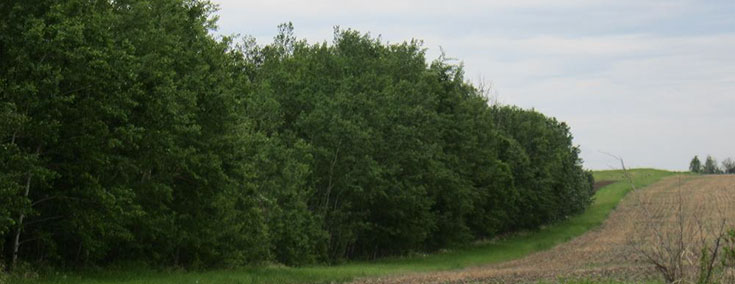
For more information about this project contact:
Scott Chang
Renewable Resources
University of Alberta,
442 Earth Sciences Building
Edmonton, Alberta, Canada T6G 2E3
Phone 780-492-6375
FAX 780-492-1767
scott.chang@ales.ualberta.ca
Website
Edward Bork
Agricultural, Food & Nutritional Sciences
University of Alberta,
4-10E Agriculture/Forestry Centre
Edmonton, Alberta, Canada T6G 2P5
Phone 780-492-3843
FAX 780-492-4265
edward.bork@ualberta.ca
Website
Project Title: Quantifying carbon sequestration and greenhouse gas emissions in planted shelterbelts, natural hedgerows and woodlands in different soil-climatic zones in Alberta.
Project Overview
The contribution of planted shelterbelt, natural hedgerow and woodland systems to carbon sequestration and reductions in greenhouse gas (GHG) emissions in different soil-climatic zones has been poorly studied, although such agroforestry systems are widely practiced across Canada. Consequently, current policies do not exist to tie these beneficial management practices (BMPs) to economic gains for producers. We anticipate that our research will demonstrate that agroforestry systems have the capacity to be effective sinks for carbon and to reduce GHG emissions. This project will enhance the understanding of agroforestry systems that can be adopted by farmers to mitigate GHG emissions in Canada.
Economic and environmental benefits of agroforestry systems
Agroforesty systems within agricultural lands are known to:
- reduce erosion
- reduce evaporation
- promote pollination
- reduce odour and improve air quality
- trap sediment in riparian areas leading to an increase of water quality
- shelter animals
- trap snowfall to increase soil moisture
- provide habitat for wildlife
- increase biodiversity
When carbon sequestration values of agroforestry systems can be verified and validated this will increase the value of existing shelterbelts, as well as turn natural hedgerows and woodlands with limited current profitability into a tangible asset capable of generating income for producers. This will encourage new agroforestry systems to be established and existing agroforestry systems to be protected to realize environmental and economic benefits.
When the carbon benefits of these agroforestry systems are scaled up to the regional and national levels, the offsets that can be claimed by the government can be substantial. Other stakeholders such as nursery tree producers and forest management contractors will benefit when agroforestry based land use systems are readily adopted by farmers, leading to a more diversified local economy. Additionally, when these agroforestry systems are widely adopted by farmers in western Canada, the host of known benefits will increase.
Summary
This project will improve our understanding of shelterbelts, hedgerows and woodlands, and ultimately identify economic opportunities for farmers to be compensated for mitigating GHGs through enhanced carbon sequestration in western Canada. Additionally, this work will provide baseline information that will be of key interest to a broader national audience as it will suggest opportunities for using agroforestry systems for the provision of environmental goods and services in other portions of Canada. Data collected from this study will complement findings from other ecosystem types or regions to broaden our understanding of the impact of different land use systems on ecosystem carbon storage and GHG emissions.
